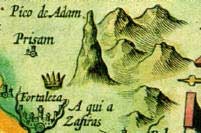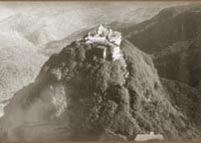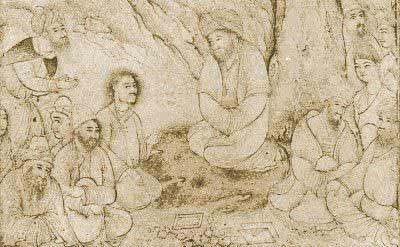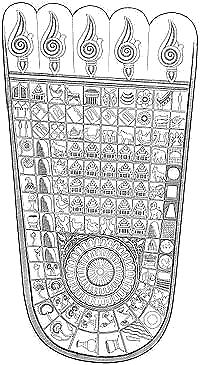The Travels of Ibn Batuta: Chapter XX

|
 |
Arrival in Ceylon - Visits the King at Battala - Natural productions - Pearls - Obtains permission to visit Adam's Peak - Arrives at Manar Mandali - Port of Salawat - Kanhar, the capital of Ceylon, described - Mosque of the Sheikh Othman - The Emperor Kinar: his white elephant - large rubies found all over Ceylon - Description of the cave Ista Mahmud - Buzuta - Monkies - Estuary of reeds - Old woman's house - Cave of Baba Tahir - Of Sibak - The fierce leech - The seven caves - Ridge of Alexander - Description of Adam's Peak - Customs of Pilgrims - Fish Port - Village of Karkun - Of Dildinuh - Of At Kalanja - City of Dinaur - Great Idol -Temple, with Brahmins, Jogees, and daughters of the Nobility - Kali - Kalambu - Battala.
WHEN we sailed, however, the wind changed upon us, and we were near being lost; but arrived at last at the island of Ceylon, a place well known, and in which is situated the mountain of Serendib. This appeared to us like a pillar of smoke, when we were at a distance of nine days from it. When we got near the land, we saw a harbour, into which we endeavoured to put, but were threatened by the Reis, who was in a ship. The reason of this was, the harbour was in a district belonging to an infidel prince, who had no intercourse with the captains of Mohammedan vessels, as other infidel princes had. He was likewise a very stupid being. He had also ships with which he occasionally transported his troops against the Mohammedans. Beside all this, we were in danger of drowning, unless we could enter the port: I said to the Reis, therefore, Allow me to come on shore, and I will ensure thy safety, and that of those about thee, with the King. To this he consented, and myself, with some of my followers only, were brought on shore. The infidels then came about us and said: What are you? I answered, I am a relation of the King of the Mābar districts, and am on a voyage to visit him: whatever is in the ship, is a present for the King of the Mābar. They then went to their king, and told him this. He therefore sent for me, and I went to him. He is king of the city of Battala, which is small, and surrounded by two wooden fences. The whole of its shore abounds with cinnamon wood, bakam, and the kalanji aloe; which, however, is not equal to the Kamari, or the Kakuli, in scent. The merchants of Malabar and the Mābar districts transport it without any other price than a few articles of clothing, which are given as presents to the king. This may be attributed to the circumstance, that it is brought down by the mountain torrents, and left in great heaps upon the shore. Between this city and the Mābar districts, there is a voyage of one day and night. The king of Ceylon, Ayari Shakarti, by name, has considerable forces by sea. When I was first admitted to his presence, he rose and received me honourably, and said: You are to be my guest for three days. Security shall be forwarded to the people of the ship, because your relation, the King of the Mābar, is my friend. After thanking him, I remained with him, and was treated with increasing respect.

One day, when I was admitted to his presence, he had with him a great number of pearls, which had been brought from the pearl-fishery, and these his companions were sorting. He asked me, whether I had ever seen pearl-diving, in any country which I had visited. I said, yes, I had, in the island of Finas. He said: Do not be shy; ask for what you wish. I answered: My only desire in coming to this island was, to visit the blessed foot of our forefather Adam; whom these people call Baba, while they style Eve, Mama. This, replied he, is easy enough. We will send some one with you, who shall conduct you thither. The ship (said I) which brought me here, shall return to the Mābar; and when I return, you shall send me there in one of your ships. He answered, It shall be so. When I told this to the commander of the ship, he refused to accede to it; and said, I will wait for you, should you be absent a whole year. This I told to the King, who said: He may stay at my charge until you return. He then gave me a palanquin, which his servants carried upon their shoulders. He also sent with me four Jogees, who were in the habit of visiting the foot-mark every year; with these went four Brahmins, and ten of the King's companions, with fifteen men carrying provisions. As to water, there is plenty of it to be found on the road. We then proceeded on our journey; and on the first day crossed a river in a boat made of reeds, and entered the city of Manar Mandali, which is handsome, and situated at the extremity of the territory of the infidel king, who had entertained and. sent us out.
The Emperor is an infidel, and is known by the name of Kinar. He has a white elephant, upon which he rides on feast days, having first placed on his head some very large rubies. This is the only white elephant I had ever seen. The ruby and carbuncle are found only in this country. These are not allowed to be exported, on account of the great estimation in which they are held: nor are they elsewhere dug up. But the ruby is found all over Ceylon. It is considered as property, and is sold by the inhabitants. When they dig for the ruby, they find a white stone abounding with fissures. Within this the ruby is placed. They cut it out, and give it to the polishers, who polish it until the ruby is separated from the stone. Of this there is the red, the yellow, and the cerulean. They call it the Manikam. It is a custom among them, that every ruby amounting in value to six of the golden dinars current in those parts, shall go the Emperor, who gives its value and takes it. What falls short of this goes to his attendants. All the women in the island of Ceylon have traces of coloured rubies, which they put upon their hands and legs as chains, in the place of bracelets and ankle-rings. I once saw upon the head of the white elephant seven rubies, each of which was larger than a hen's egg. I also saw in the possession of the king Ayari Shakarti, a saucer made of ruby, as large as the palm of the hand, in which he kept oil of aloes. I was much surprised at it, when the King said to me, We have them much larger, than this.
We then proceeded from Kankar, and came to a cave known by the name of Ista Mahmud, then to the estuary of Buzuta, which in their language signifies monkies, animals which are in great numbers in the mountains of these parts. These monkies are black, and have long tails: the beard of the males is like that of a man. I was told by the Sheikh Othman and his son, two pious and credible persons, that the monkies have a leader, whom they follow as if he were their king. About his head is tied a turban composed of the leaves of trees; and he reclines upon a staff. At his right and left hand are four monkies, with rods in their hands, all of which stand at his head whenever the leading monkey sits. His wives and children are daily brought in on these occasions, who sit down before him; then comes a number of monkeys, which sit and form a sort of assembly about him. One of the four monkeys then addresses them, and they disperse. After this each of them comes with a nut, a lemon, or some of the mountain fruit, which he throws down before the leader. He then eats, together with his wives, children, and the four principal monkeys; they then all disperse. One of the Jogees also told me, that he once saw the four monkeys standing in the presence of the leader, and beating another monkey, with rods; after this they plucked off all his hair. I was also told by respectable persons, that if one of these monkeys happens to attack, and be too strong for a young woman, he will ravish her.
We next proceeded to the estuary of reeds, where rubies are also found. The next place we arrived at is known by "The house of the old woman," which is the farthest inhabited part of the island of Ceylon. Our next stage was the cave of Baba Tahir, who was one of the pious: the next, the cave of Sibak, an infidel king, who retired to this place for the purposes of devotion. Here we saw the fierce leech, which they call the zalaw. It remains in trees, or in the grass near water. When any one comes near to it, it springs upon him, and the part of the body attacked will bleed profusely. People generally provide themselves with a lemon for this occasion, which they squeeze over him, and then he drops off. The place upon which the leech has fastened they cut out with a wooden knife made for that purpose.
It is told of a pilgrim who passed by this place, that a leech fastened upon him, so that the skin swelled; and, as he did not squeeze the lemon on him, the blood flowed out and he died.
We next came to a place called the seven caves, and after this to the Ridge of Alexander; in which is a cave and a well of water. At this place is the entrance to the mountain. This mountain of Serendib is one of the highest in the world: we saw it from the sea at the distance of nine days. When we ascended it, we saw the clouds passing between us and its foot. On it is a great number of trees, the leaves of which never fall.
There are also flowers of various colours, with the
red rose, about the size
of the palm of the hand, upon the leaves of which they think they can read the
name of God and of his Prophet. There are two roads on the mountain leading to
the foot (of Adam); the one is known by "the way of Baba,"
the other, by "the way of Mama,"
by which they mean Adam and Eve. The way called that of Mama is easy: to
it the travellers come upon their first visiting the place; but every one who
has travelled only upon this, is considered as if he had not made the pilgrimage
at all. The way named Baba is rough, and
difficult of ascent. At the foot of the mountain where the entrance is, there is
a minaret named after Alexander, and a fountain of water. The ancients have cut
something like steps, upon which one may ascend, and have fixed in iron
pins, to which chains are appended; and upon these those who ascend take hold.
Of these chains there are ten in number, the last of which is termed "the
chain of witness," because, when one has arrived at this, and looks down,
 the frightful notion seizes him that he shall fall. After the tenth chain is the
cave of Khizr, in which there is a large space; and at the entrance a well,
of water, full of fish, which is also called after his name. Of those, however,
no one takes any. Near this, and on each side of the path, is a cistern cut in
the rock. In this cave of Khizr the pilgrims leave their provisions, and
whatever else they have, and then ascend about two miles to the top of the
mountain, to the place of (Adam's) foot. The holy foot (mark) is in a stone, so
that its place is depressed. The length of the impression is eleven spans. The
Chinese came here at some former time, and cut out from this stone the place of
the great toe, together with the stone about it, and placed it in a temple in
the city of Zaitun: and pilgrimages are made
to it from the most distant parts of China. In the rock, too; in which the
impression of the foot is, there are nine excavations which have been cut out:
into these the infidel pilgrims put gold, rubies, and other jewels: and
hence you will see the Fakeers, who have come as pilgrims to the well of Khizr,
racing to get first to the excavations, in order to obtain what may be in them.
We, however, found nothing but a little gold with some rubies, which we gave to
our guide.
the frightful notion seizes him that he shall fall. After the tenth chain is the
cave of Khizr, in which there is a large space; and at the entrance a well,
of water, full of fish, which is also called after his name. Of those, however,
no one takes any. Near this, and on each side of the path, is a cistern cut in
the rock. In this cave of Khizr the pilgrims leave their provisions, and
whatever else they have, and then ascend about two miles to the top of the
mountain, to the place of (Adam's) foot. The holy foot (mark) is in a stone, so
that its place is depressed. The length of the impression is eleven spans. The
Chinese came here at some former time, and cut out from this stone the place of
the great toe, together with the stone about it, and placed it in a temple in
the city of Zaitun: and pilgrimages are made
to it from the most distant parts of China. In the rock, too; in which the
impression of the foot is, there are nine excavations which have been cut out:
into these the infidel pilgrims put gold, rubies, and other jewels: and
hence you will see the Fakeers, who have come as pilgrims to the well of Khizr,
racing to get first to the excavations, in order to obtain what may be in them.
We, however, found nothing but a little gold with some rubies, which we gave to
our guide.
It is customary for the pilgrims to remain in the cave of Khizr for three days; and during this time to visit the foot both morning and evening. This we did; and when the three days were expired we returned by the path of Mama, and came down to the cave of Shisham, who is Sheth, the son of Adam. After this we arrived at the fish port, then at the village of Karkun, then at the village of Dildinuh, then at the village of At Kalanja, where the tomb of Abu Abd Allah Ibn Khafif is situated. All these villages and tilled. lands are upon the mountain. At its foot, and near the path, is a cypress, which is large and never drops the leaf. But as to its leaves, there is no getting to them by any means; and these people's heads are turned with some strange and false notions respecting them. I saw a number of Jogees about the tree, waiting for the falling of one; for they suppose that any person eating one of them, will grow young again, however old he may be. Beneath this mountain is the great estuary at which the rubies are obtained; its water appears wonderfully blue to the eye.
From this place we proceeded, and in two days arrived at the city of Dinaur, which is large, and inhabited by merchants. In this is an idol, known by the same name, placed in a large temple; and in which there are about a thousand Brahmins and Jogees, and five hundred young women, daughters of the nobility of India, who sing and dance all night before the image. The officers of the city revenue attend upon the image. The idol is of gold, and as large as a man. In the place of eyes it has two large rubies; which, as I was told, shine in the night-time like two lighted candles.
From this place we travelled to Kali, which is a large town; then to Kolambu (Colombo), which is the finest and largest city in Serendib. After three days we arrived at the city of Battala, from which we had been sent by its king, with his servants, to visit (Adam's) foot. This we entered, and were received honourably by the king, who furnished us with provisions.
From: The Travels of Ibn Batuta; Translated from the Abridged Arabic Manuscript Copies, preserved in the Public Library of Cambridge. Translated by Rev. Samuel Lee. London: Printed for the Oriental Translation Committee, 1829, 183-192.